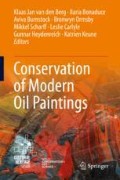Abstract
In the first half of the twentieth century in Norway, linseed oil was the primary binding medium used in house paint, decorative paint and artists’ paint. During the First World War (WWI), however, the cost of linseed oil rose dramatically. In 1917, it was rationed, and it then became unavailable for commercial paint use. What were the consequences of the restricted access to linseed oil? To examine this question, articles and advertising published in Maleren, a biweekly Norwegian journal for house and decorative paint, with house painters and architects as the target audience, were studied. The research results show that a range of so-called surrogate products became available in Norway during WWI. Diverse materials were used as binding media in the paint, and the quality of the available paint products varied widely. The research contributes to a broader understanding of the house painters’ market in this complex period and gives important background information for conservators examining architectural decorations as well as easel paintings which were created in Norway during WWI.
Access this chapter
Tax calculation will be finalised at checkout
Purchases are for personal use only
References
Alf Bjercke Fernisfabrik (1915) Alf Bjerckes fernisser. Pamphlet in Maleren nr. 7. Alf Bjercke Fernisfabrik, Oslo
Andersen CC (1949) Utnyttelse av sulfittavluten. Teknisk ukeblad 24:378–383
Aslaksby TE (2012) Christian Krogh and photography: some observations and reflections. In: Hansen et al (eds) Christian Krohg: pictures that captivate. Nasjonalmuseet for kunst, arkitektur og design, Oslo
Baty P (2017) The anatomy of colour: the story of heritage paints and pigments. Thames & Hudson, London
Beltinger K, Nadolny JM (2016) Painting in tempera, c. 1900. Schweizerisches Institut für Kunstwissenschaft in association with Archetype, London
Brænne J (1998) Dekorasjonsmaling: marmorering, ådring, lasering, patinering, sjablondekor, strukturmaling. Teknologisk forlag, Oslo
Dredge P (2012) A history of Australian housepaint technology from the 1920s to the 1950s, with reference to its use by Australian artists, particularly Sidney Nolan. AICCM Bulletin, 33(1):53–61
Halse OM, Samuelsen S (1918) Undersøkelse av en norsk træterpentinolje. Tidsskrift for Kemi 11:177–184
Kokkori M et al (2014) Charting the development of oil-based enamel paints through the correlation of historical paint technology manuals with scientific analysis. In: van den Berg KJ et al (eds) Issues in contemporary oil paint. Springer International Publishing, Cham, p 117–125
Larsen LPH (2012) Fett -og Oljeforsyningen under 1. verdenskrig: En analyse av statens reguleringer og Statens Fettdirektorat. Master thesis, Norges teknisk-naturvitenskapelige universitet, Trondheim.
Maleren (1908–) Malermestrenes landsforbund in association with Skarland Press AS, Oslo
Meissner K, Brekke A (2017) Tranprosjektet: produksjon og maling med tran fra seilever: sluttrapport. Byggkult AB, Öland
Schiørn F (1937) Olie- og farvehandlerforeningen i Oslo gjennem 50 år 1887–1937. Olie- og farvehandlerforeningen i Oslo in assosiation with Emil Moestue AS, Oslo
Schiøtz O (2010) A thousand years of Lofoten cod-liver oil: Lofoten, a global manufacturer. Museum Nord—Norsk fiskeværsmuseum, Å in Lofoten
Standeven HAL (2011) House paints, 1900–1960: history and use. Getty Conservation Institute, Los Angeles
Acknowledgments
Grateful thanks are extended to the Norwegian Research Council for the provision of funding.
Author information
Authors and Affiliations
Corresponding author
Editor information
Editors and Affiliations
Rights and permissions
Copyright information
© 2019 Springer Nature Switzerland AG
About this chapter
Cite this chapter
Wedvik, B. (2019). A Glimpse into the House and Decorative Paint Market in Norway During World War I (1914–1918). In: van den Berg, K., et al. Conservation of Modern Oil Paintings. Springer, Cham. https://doi.org/10.1007/978-3-030-19254-9_6
Download citation
DOI: https://doi.org/10.1007/978-3-030-19254-9_6
Published:
Publisher Name: Springer, Cham
Print ISBN: 978-3-030-19253-2
Online ISBN: 978-3-030-19254-9
eBook Packages: Chemistry and Materials ScienceChemistry and Material Science (R0)

